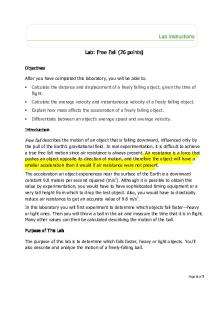Motion in Free Fall Lab Report PDF

| Title | Motion in Free Fall Lab Report |
|---|---|
| Course | LPhysics I Lab |
| Institution | University of Massachusetts Lowell |
| Pages | 3 |
| File Size | 89.6 KB |
| File Type | |
| Total Downloads | 10 |
| Total Views | 187 |
Summary
Motion in Free Fall Lab Report...
Description
Objective: The motion of a body falling freely under gravitational attraction will be examined, and from the measured rate at which the velocity changes with time, the acceleration due to gravity will be determined. Procedure: 1) Cut 60 centimeters of tape, form a loop at one end, and slide the other end through the timer unit. Attach a 200 g weight from the loop. 2) Set the timer to 40 Hz and drop the weight to the floor. A new dot will now be created every 40th of a second. 3) Remove the weight and the first few cluttered dots on the tape. Measure the distance between the first dot (s=0) and every other dot. Then measure the distance between each successive dot. 4) Calculate average velocity, which equals the instantaneous velocities at the midpoint of each time interval. Analysis: The first data to be calculated in Table 1 was the distance between the nth dot and the 0th dot (sn), which was measured in centimeters with a meter stick. The values of sn initially began very small at 2.0 centimeters, but as n increased, sn rapidly grew until the distance was 78.2 centimeters at the final dot. This data can be seen in Graph 1, which demonstrates displacement vs. time. Graph 1 clearly shows an increasing curved line. Next, the midpoint time of each dot
n
1
was calculated. To accurately make this calculation, the time ( 40) was multiplied by 2, to ultimately make the time equal to
n 80
. Velocity was then calculated with the equation 𝐯 =
∆𝐬 ∆𝐭
,
which resulted in 𝐯 = 𝟒𝟎 ∗ ∆𝐬. This data can graphically be seen in Graph 2, which represents instantaneous velocity vs. time. A straight line was created, and the slope of the line results in a constant acceleration. To determine the slope of this graph, two points were taken, and plugged into the equation
v𝑏 −v𝑎 . t𝑏 −t𝑎
The two points that I used were at n=5 and n=8, where the slope ended
up equaling 960 cm/s2, which converts to 9.60 m/s2. The instantaneous velocities that were found from the midpoints of the two graphs can also be found on Table 2. Table 2 was found using the slope of the tangents of the graphs of displacement vs. time. Discussion: The values that were found ended up being very accurate, but there are certainly some inaccuracies that could have made the results even more exact. Human error is always a major factor with any inaccuracy. Meter sticks and calipers do not measure to an infinite decimal place, so having the data get consistently rounded to a first or second decimal place would end up altering the final result. However, ending with acceleration due to gravity of 9.6 m/s2 instead of 9.8 m/s2 gives only a 2.0% error, which is extremely precise. Conclusion: When an object is in free fall, its acceleration is increasing at a constant rate, thus making the velocity increase at a constant rate. Knowing this, the displacement of an object under a gravitational force must have an exponential increase. Questions:
1) The difference between my value of g and the accepted value of g is 0.2 m/s 2 because 9.8-9.6=0.2. I believe that the principle source of experimental uncertainty would be human error. As mentioned above, it is nearly impossible to measure to an infinite decimal place. 2) A downward force would result in a larger velocity, and it will accelerate at a faster pace. 3) A body in free-fall will pick up more speed the longer it is falling. The slope of a curved displacement graph would be a linear velocity graph. 4) Yes, the tangent should be horizontal at (0,0) because as the time increases, the tangent line gets steeper. So when the time equals 0, the displacement is constant at 0, making the slope 0 as well....
Similar Free PDFs

Motion in Free-Fall Lab Report
- 13 Pages

Motion in Free Fall Lab Report
- 3 Pages

Free Fall Motion Lab - lab
- 5 Pages

Motion lab - Lab Report
- 8 Pages

Week 4 - FREE FALL - lab report
- 6 Pages

Projectile Motion Lab Report
- 15 Pages

Projectile Motion Lab report
- 13 Pages

LINEAR MOTION lab report
- 7 Pages

Projectile Motion Lab Report
- 3 Pages

Lab-Free Fall - Physics 1
- 7 Pages

Lab 3 ( kinematic free fall)
- 11 Pages

Equations of Motion - Lab report
- 9 Pages
Popular Institutions
- Tinajero National High School - Annex
- Politeknik Caltex Riau
- Yokohama City University
- SGT University
- University of Al-Qadisiyah
- Divine Word College of Vigan
- Techniek College Rotterdam
- Universidade de Santiago
- Universiti Teknologi MARA Cawangan Johor Kampus Pasir Gudang
- Poltekkes Kemenkes Yogyakarta
- Baguio City National High School
- Colegio san marcos
- preparatoria uno
- Centro de Bachillerato Tecnológico Industrial y de Servicios No. 107
- Dalian Maritime University
- Quang Trung Secondary School
- Colegio Tecnológico en Informática
- Corporación Regional de Educación Superior
- Grupo CEDVA
- Dar Al Uloom University
- Centro de Estudios Preuniversitarios de la Universidad Nacional de Ingeniería
- 上智大学
- Aakash International School, Nuna Majara
- San Felipe Neri Catholic School
- Kang Chiao International School - New Taipei City
- Misamis Occidental National High School
- Institución Educativa Escuela Normal Juan Ladrilleros
- Kolehiyo ng Pantukan
- Batanes State College
- Instituto Continental
- Sekolah Menengah Kejuruan Kesehatan Kaltara (Tarakan)
- Colegio de La Inmaculada Concepcion - Cebu



